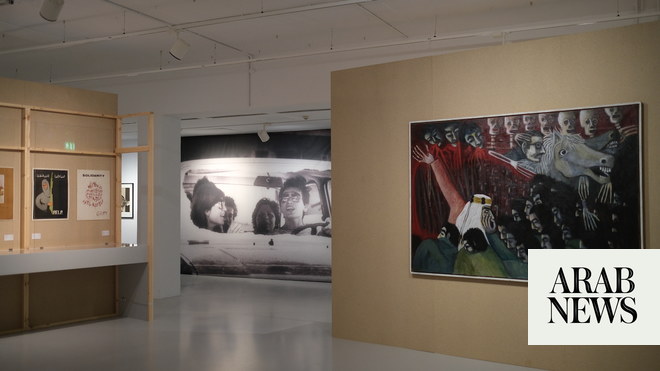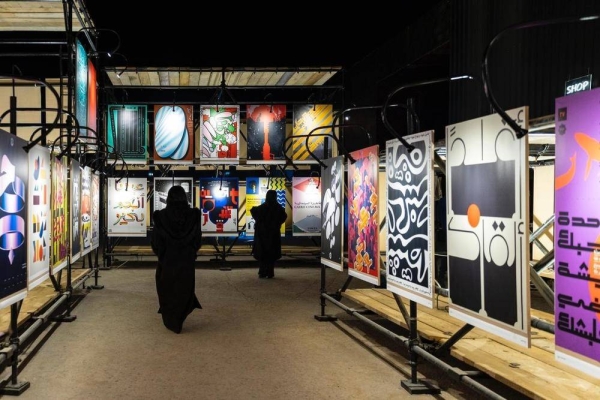
DUBAI: Music in a gallery room in Doha’s Mathaf Arab Museum of Modern Art signals a celebratory scene — it is, in fact, part of “Beirut and the Golden Sixties: A Manifesto of Fragility,” a new exhibition of artworks, films and archival material co-curated by Sam Bardaouil and Till Fellrath.
For the latest updates, follow us on Instagram @arabnews.lifestyle
The exhibition charts the 1960s in Beirut, a decade often described as the city’s “golden age.” Featuring 230 artworks and 300 archival documents from around 40 collections worldwide, the show explores a period of creativity during the heightened political years from 1958 to 1975, an era that ended with the Lebanese civil war.
Lebanon is again facing a period of upheaval amid an economic crisis, political stalemate and the fallout from the 2020 Beirut port blast.
“Staging an exhibition about Beirut at this particular moment comes with a heightened sense of responsibility,” Bardaouil told Arab News.
“We are aware of the struggles and challenges that many people are facing on a daily basis in Lebanon, and doing an exhibition that looks at Beirut’s cultural history is, in a way, an attempt to understand the roots of a lot of the problems that are still at play today.”
On display is the work of internationally renowned Lebanese artists, including Etel Adnan, Huguette Caland, Paul Guiragossian, Saloua Raouda Choucair, and Shafic Abboud, as well as celebrated artists working in the region, such as Adel Saghir, Cici Sursock, Nadia Saikali and Rafic Charaf.
The show unfolds through a series of rooms arranged by themes, beginning with “Le Port de Beyrouth: The Place,” which depicts Lebanon and its many contradictions, including those who benefitted from Beirut’s prosperity and those who watched on in destitution.
An oil painting of the city by Caland, titled “Une Ville” (1968), sits amid archival materials and exhibition posters. Another work by Adnan, titled “Le Port de Beyrouth” (1974), made with charcoal on paper, offers an almost endearing abstract sketch of the city.
Another section, “Monster and Child: The Politics,” traces the rapid escalation of political and social tensions from the late 1960s until the outbreak of war in 1975.
Regional crises, such as the 1973 Arab-Israeli war, also broke out during this time. In this section, Aref El-Rayess’ “Fifth of June (The Changing of Horses),” an oil on canvas completed in 1967, depicts a row of beheaded men and another of mourners — a reference to the events of June 5, 1967, when the Israelis occupied East Jerusalem, the West Bank, the Golan Heights and the Gaza Strip.
“By staging the exhibition at Mathaf you can contextualize the story of modern art in Beirut and Lebanon within a larger picture, and that is very important,” Bardaouil said.
“The contributions of these artists, their connections with artists from other countries, neighboring countries, and the common thread to common questions that each of these artists were articulating — this is a very important exercise in contextualization.”
Artworks displayed capture the same contradictions that continue to plague Lebanese society. Politically charged works are shown alongside works that show festivity, joy and desire.
The section “Lovers: The Body” features acclaimed Lebanese female artists, such as Simone Fattal, and explores how changing social values in Beirut and across the world during the 1960s inspired new artistic movements.
The notion of the past mirroring the present is underscored in a newly commissioned multimedia installation by Joana Hadjithomas and Khalil Joreige about the devastation caused by the 2020 port explosion.
Staged in the final section of the exhibition, titled “Blood of the Phoenix: The War,” the installation includes footage shot from the Sursock Museum on Aug. 4 when the deadly blast occurred.
In a digital work titled “But my head is still singing,” Hadjithomas and Joreige recount the Greek myth of Orpheus and draw parallels with Lebanon’s tragedy.
After the death of his wife Eurydice, who Orpheus tried to bring back from the dead with his enchanting music, he was torn to pieces by a group of irate women. According to the myth, however, his severed head kept singing even after death.
As Hadjithomas tells Arab News: “Even after such a tragedy we are like Orpheus; we are still singing.












